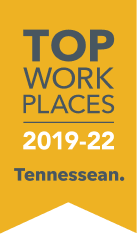Think about your organization’s team members. Which traits do your leading employees share? A set of skills, a history of successful work, a certain personality—or a combination of all three? No matter why they rise to the top, when you find them you’re going to want to hang onto them.
Retaining top talent goes beyond an above-average benefits package and compensation. These factors may contribute to a team member’s decision to stay with your company, but ultimately high performers want to be held accountable to greatness.
We caught up with Adam Winstead, Vice President of Human Resources and Operations at GS&F, to dig into what makes high performers tick and how your organization can serve them well.
Identifying the Best of the Best
“Top talent changes in every organization,” Winstead says. “It involves the basics— drive, determination, taking initiative—but you can define what it means for your team.”
Winstead recommends thinking about your organization’s top performers and considering their characteristics. What draws you to them from a performance standpoint? What do they do that goes beyond the basics and truly sets them apart? Once you’ve reviewed your standouts, you can create a profile that guides your thinking.
By reviewing each team individually, you can make your profiles even more specific and useful. “Remember, every team within an organization can have a different definition of top talent,” Winstead adds.
Retaining High Performers
“Culture is likely the number one aspect of retention,” he adds. “You want to make sure people can achieve their best work within your organization’s culture.” When employees know they have space to do their best work and their needs are met, the likelihood that they’ll remain with your organization increases.
“It’s also important to be both intentional and responsive,” says Winstead. First and foremost, this means creating a structure and environment where employees want to stay. But additionally you must stay close to your teams, engaging regularly, so you can keep in touch with their needs and actively create solutions. “Anytime you focus too heavily on the work and miss your teams’ needs,” Winstead says, “a disconnect can emerge.”
Intentionality also involves a few practical methods to keep in touch with your teams. For example, frequent, intentional one-on-ones or daily standup meetings are a must, according to Winstead. Adding team-wide surveys to help check the pulse of the organization can be a good way to incorporate quarterly or yearly feedback as well. Ultimately, intentional communication—at least every other week—allows you to respond to your teams’ needs and ensure they are fulfilled in their work.
Parting Ways Well
Winstead notes, too, that sometimes parting ways becomes part of a high performer’s story. When someone leaves the GS&F team seeking growth and with curiosity for pursuing greatness, it’s easy to feel a mix of excitement and sadness.
“We can always learn from each person’s experience,” Winstead says. “We can consider what we can do to support high performers like them in the future and ensure they know we’re always there to support them in the long term.” Even making sure your exit interviews allow for conversation and go beyond surface-level questions can help you gain the insight you need.
Creating an Environment for Top Performers to Thrive
“Top talent wants to know they have the environment to be great and a manager who is truly partnering with them to get there,” Winstead notes. When performance and growth dovetail with heart, true greatness can come to life.
How is your organization creating an environment for your team members to thrive, grow and develop? Take stock of your brand’s values and promises, examine your management structure, and work to define what top talent looks like for you and your teams. Then the fun begins—helping your teams be the best they can be.
For more on how GS&F approaches talent retention, check out how our teams come together to make our work great, how we lead hearts-first, and how we celebrate each other.
Adam Winstead, Vice President, Human Resources and Operations, contributed to this post.

